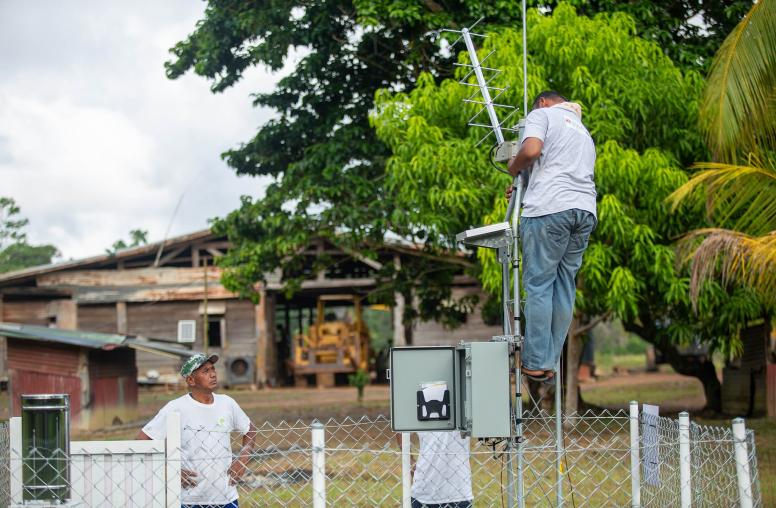The Geopolitics of Deep-Sea Mining and Green Technologies
With renewable energy technology on the rise, how can we prevent tensions over the minerals that create it?
For the first time, the International Energy Agency is reporting that global demand for fossil fuels will peak or plateau in the next decade as the world transitions to renewable energy. This is a welcome development ahead of the 27th U.N. Climate Change Conference (COP27), which includes a focus on the “promise of innovation and clean technologies” to mitigate the climate crisis. However, there is often a disconnect between the prospect of green technologies and the reality surrounding the minerals and materials required to produce them.

As demand for fossil fuels levels off, renewable energy sources will occupy a larger and larger percentage of the total demand for the minerals involved in their creation. Within the next two decades, the IEA predicts that renewable energy technology will make up over 40 percent of the demand for copper, 60 to 70 percent for cobalt and nickel, and 90 percent for lithium.
To avoid the tremendous social and environmental costs of land-based mining, nations — including China and the United States — are turning towards the ocean floor to secure the materials for their renewable energy needs through a process called deep-sea mining.
What Is Deep-Sea Mining?
Deep-sea mining (DSM) involves retrieving mineral deposits from nodules that dot the ocean floor, typically more than 600 feet below sea level. The most economically viable nodules lie partially under sediment in the north-central Pacific Ocean, the southeastern Pacific Ocean, and the northern Indian Ocean. These valuable nodules contain cobalt, copper, nickel and other minerals required to produce green technologies like electric vehicles, solar panels and wind turbines.
However, the regulatory oversight of this practice is a major source of geopolitical tensions. The U.N. Convention on the Law of the Sea (UNCLOS) mandates that states govern deep-sea mining on seabed within their national jurisdiction.
But roughly 60 percent of the ocean bottom is located beyond the jurisdiction of individual states. In these waters, deep-sea prospecting (the search for minerals and metals), exploration (assessments of the location, size and quantity), and exploitation (the recovery and delivery of economic amounts of minerals and metals) is regulated by the UNCLOS-created International Seabed Authority (ISA).
Some states, including world powers, have differing, competing or incompatible interpretations of UNCLOS or domestic maritime laws. Areas of disagreement include maritime boundaries as well as what nations are entitled to do or disallow both within and outside those boundaries.
The ISA has tried to govern DSM issues with the Mining Code. But the code is incomplete, with only exploration regulations finalized and exploitation laws still under review. In 2021, Nauru — an island nation in the Central Pacific — announced its intention to transition from exploration to exploitation, creating even more urgency for the ISA to finalize regulations.
The Rise of Geopolitical Competition
Demand for exploiting minerals on the seabed is rising. But the hasty development of a DSM regulatory framework could heighten geopolitical competition and environmental degradation.
China, in particular, has demonstrated its desire to shape international norms in the maritime domain, as exemplified by Beijing’s aggressive actions in the South China Sea and DSM. Already dominating terrestrial mining, China is now leading the race to the bottom of the sea by building superior capabilities and influencing the regulatory environment. China currently holds five out of the 30 deep-sea mining contracts issued by the ISA — more than any other country.
Under the ISA, member states must ensure that actions taken under an exploration license abide by UNCLOS law. And while the Chinese DSM law details environmental obligations under the UNCLOS, the requirements are vague, creating lax regulation. As such, China can influence operational practices and environmental norms.
China is also a leader in research and development and has unrivaled mineral processing capabilities. DSM research is expensive, and companies require large amounts of capital to operationalize. But the Chinese government has made funding for deep sea mining research a national security and economic priority. Chinese state-owned enterprises are given preferential access to loans from state banks with lower interest rates, which offer them an advantage over companies operating in the free market.
Meanwhile, the United States is not a member state of UNCLOS or the ISA, having signed but not ratified the UNCLOS treaty. This leaves the United States with a limited ability to shape DSM regulatory framework. The UNCLOS also requires that DSM companies be based in a member state, meaning U.S. companies are unable to access ISA deep-sea mining contracts.
To get around the issue, the United States has passed its own law on seabed mining that allowed NOAA to issue exploration licenses for international DSM. However, despite receiving licenses, U.S. companies like Lockheed Martin are hesitant to begin DSM operations — citing a lack of international recognition.
By creating parallel regulations rather than ratify the UNCLOS, the United States risks weakening the incentive to comply with international law — and sets a dangerous precedent that could empower malign actors. The United States also relies on Chinese terrestrial mining for critical minerals. Without international recognition for DSM activities, U.S. companies will fall further behind, making it unlikely the United States will shift reliance away from China.
Enhancing Global Governance to Manage Risks
The Biden-Harris National Security Strategy emphasizes identifying opportunities for cooperation and working with U.S. allies and partners to “secure access to critical mineral supply chains” as the United States works to mitigate climate change and bolster energy security.
At COP27, the United States can further these goals by elevating the connection between responsible critical mineral extraction, climate change mitigation and the need for internationally recognized DSM exploitation regulation. The conference provides an opportunity to prioritize forming a consensus on updated international DSM regulation, which can reduce geopolitical tensions around critical climate and security issues.
While the United States has not ratified the UNCLOS, it can encourage and advise members — such as the EU, Canada and the United Kingdom — that will vote on ISA regulation. Policymakers can also prioritize strengthening and forming new working relationships with governments at COP27, as efforts to protect the environment and mitigate climate change will require global cooperation beyond traditional allies and partners.
The United States can also speak with partners about adopting trade policies that promote sustainable DSM practices. For example, policymakers could create regulations that restrict the importation of products that use deep sea materials — with a carveout for companies that meet environmental and enforcement standards. Regulations like this will be particularly effective in incentivizing companies to uphold responsible exploration and exploitation as they prepare for commercialization, with the United States being a large target market. And while U.S.-China competition is intensifying, the two nations should prioritize cooperation on the common threat of climate change.
Scientists still do not know the extent to which DSM affects the environment. But mismanaged deep-sea exploration and extraction could degrade biodiversity, water quality and fish stocks as well as change ocean currents. The United States should utilize its bilateral relationships and leadership in multinational organizations, like the United Nations, to promote scientific exploration and the protection of biodiversity as guiding principles of DSM regulation. The United States can lead efforts to bridge climate change mitigation and sustainable extraction — as well as enhance global governance of deep-sea mining within multilateral bodies — to mitigate environmental degradation and incentivize cooperation between nations attempting to secure critical mineral supply chains.
Jocelyn Trainer is a researcher and expert for the energy, economics and security program at the Center for a New American Security.



